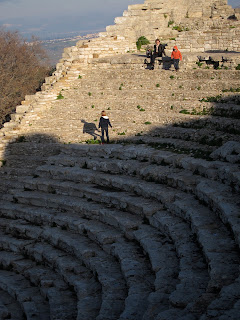We woke refreshed and hungry. The area around our apartment—which we had not been able to see the night before—was beautiful and lush, all rolling hills and vineyards, with Mount Etna looming between the clouds in the distance. Mount Etna is the highest and most active volcano in Europe. After some breakfast, we talked with some fellow guests and the proprietor about how best to see the volcano. I had read that if you go with a guide, you can see lava flows, but the proprietor told us there had not been any eruptions lately.
Instead, we drove up, up, up for about a half hour, arriving at the Rifugio Sapienza, where there are several snack bars and souvenir shops, and a gondola you can take from there, at 1900 meters to 2500 meters. It was significantly colder, and we all bundled up with all of the layers we had, plus hats and gloves. We plunked down 83 euros and hopped aboard a gondola. It was only then that I realized I might not be so happy in a small box hanging from a wire cable up a mountain. I’m not a fan of heights, but I often get myself in situations and only realize that I should have considered my options more carefully once my breath is coming fast and shallow. Well, there was no getting off at that point, so I tried to banish all thoughts of getting stuck, of the cable snapping, of the wind whipping our rickety box around.
Once we got off, I breathed a sigh of relief and took in the beauty. Patches of snow dotted the ground and the volcanic gravel crunched under our feet. We climbed up a fair bit more, but were unprepared for a real hike. The air felt thin in our lungs, and we got out of breath quickly. We had traveled above the clouds, and it felt like we were on another planet altogether. The kids made snowballs and created rockslides on the hills. We walked far enough to work up a nice appetite for lunch, and then took the gondola back down. The ride back down seemed much faster.
Once again, the restaurant we had picked out for lunch was closed, so we went to Orchidea Pizzeria. Again, reviewers raved about the pizza baked in a wood-fired oven. Orchidea was open, but no pizza. Our waiter recommended the canneloni, which was not on the menu, so we figured we should try it. We ordered one plate to split but got two, which was just as well because it was delicious. I had a mushroom soup, made with several kinds of meaty mushrooms the proprietor picked himself on Mount Etna. It came with a bowl of freshly made croutons, about 2 inches square, and was a meal on its own. I was so full when we finished that I worried we had made a tactical error—we had reservations to eat New Year’s Eve dinner at the agriturismo. But that wasn’t until 9 o’clock, so I figured we’d have room by then.
I was supposed to go taste the agriturismo’s wine at 6 o’clock, but fell asleep under the down comforter and then had a long, hot bath instead. When it was time to go down to dinner, I still felt full. I should not have worried—dinner was, in Alec’s words “aggressively bad.” When we arrived at the dining room, it was already packed, and the wait staff promptly set plates of appetizers in front of us. Given that it seemed we had arrived late, we thought perhaps the first course had suffered from sitting around waiting for us. But no, the subsequent courses—and there were several—were no better. We were grateful for the lunch we had eaten earlier, but distressed to find such a poor meal at the agriturismo.
Fortunately, the atmosphere helped make up for it. Most of the tables held parties of 12, 18, 20 people—families with babies, children the ages of our kids, a few grandparents sprinkled in here and there. Everyone seemed to be in a good mood. They tucked into their food, the wine flowed, and a pianist played American standards like “Imagine,” “New York New York,” and “Piano Man.”
Just before midnight the waiters came through to pass out sparklers, and everyone counted down and started singing. Outside we could see all kinds of fireworks being set off in the towns below. Alec and C.C. stepped outside for a better view, but Milo and I got swept up in a conga line before we could join them. A patio off of the dining room had been tented and set up as a dance floor, and a DJ started blasting the dance music—“Billie Jean,” “YMCA,” “Celebrate.” The place was hopping. Pretty soon most of the wait staff were dancing with the guests. After plenty of dancing, the kids started to wilt, and we headed back up the hill to our room. So far, 2011 is pretty good.
















